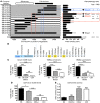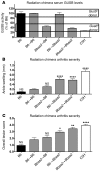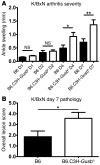Lysosomal β-glucuronidase regulates Lyme and rheumatoid arthritis severity
- PMID: 24334460
- PMCID: PMC3871255
- DOI: 10.1172/JCI72339
Lysosomal β-glucuronidase regulates Lyme and rheumatoid arthritis severity
Abstract
Lyme disease, caused by the spirochete Borrelia burgdorferi, is the most prevalent arthropod-borne illness in the United States and remains a clinical and social challenge. The spectrum of disease severity among infected patients suggests that host genetics contribute to pathogenic outcomes, particularly in patients who develop arthritis. Using a forward genetics approach, we identified the lysosomal enzyme β-glucuronidase (GUSB), a member of a large family of coregulated lysosomal enzymes, as a key regulator of Lyme-associated arthritis severity. Severely arthritic C3H mice possessed a naturally occurring hypomorphic allele, Gusbh. C57BL/6 mice congenic for the C3H Gusb allele were prone to increased Lyme-associated arthritis severity. Radiation chimera experiments revealed that resident joint cells drive arthritis susceptibility. C3H mice expressing WT Gusb as a transgene were protected from severe Lyme arthritis. Importantly, the Gusbh allele also exacerbated disease in a serum transfer model of rheumatoid arthritis. A known GUSB function is the prevention of lysosomal accumulation of glycosaminoglycans (GAGs). Development of Lyme and rheumatoid arthritis in Gusbh-expressing mice was associated with heightened accumulation of GAGs in joint tissue. We propose that GUSB modulates arthritis pathogenesis by preventing accumulation of proinflammatory GAGs within inflamed joint tissue, a trait that may be shared by other lysosomal exoglycosidases.
Figures






Similar articles
-
Forward genetic approaches for elucidation of novel regulators of Lyme arthritis severity.Front Cell Infect Microbiol. 2014 Jun 5;4:76. doi: 10.3389/fcimb.2014.00076. eCollection 2014. Front Cell Infect Microbiol. 2014. PMID: 24926442 Free PMC article. Review.
-
Borrelia burgdorferi arthritis-associated locus Bbaa1 regulates Lyme arthritis and K/B×N serum transfer arthritis through intrinsic control of type I IFN production.J Immunol. 2014 Dec 15;193(12):6050-60. doi: 10.4049/jimmunol.1401746. Epub 2014 Nov 5. J Immunol. 2014. PMID: 25378596 Free PMC article.
-
5-Lipoxygenase-deficient mice infected with Borrelia burgdorferi develop persistent arthritis.J Immunol. 2011 Mar 1;186(5):3076-84. doi: 10.4049/jimmunol.1003473. Epub 2011 Jan 26. J Immunol. 2011. PMID: 21270404 Free PMC article.
-
Susceptibility to experimental Lyme arthritis correlates with KC and monocyte chemoattractant protein-1 production in joints and requires neutrophil recruitment via CXCR2.J Immunol. 2003 Jul 15;171(2):893-901. doi: 10.4049/jimmunol.171.2.893. J Immunol. 2003. PMID: 12847259
-
Hamster and murine models of severe destructive Lyme arthritis.Clin Dev Immunol. 2012;2012:504215. doi: 10.1155/2012/504215. Epub 2012 Feb 22. Clin Dev Immunol. 2012. PMID: 22461836 Free PMC article. Review.
Cited by
-
The Cdkn2a gene product p19 alternative reading frame (p19ARF) is a critical regulator of IFNβ-mediated Lyme arthritis.PLoS Pathog. 2022 Mar 24;18(3):e1010365. doi: 10.1371/journal.ppat.1010365. eCollection 2022 Mar. PLoS Pathog. 2022. PMID: 35324997 Free PMC article.
-
Forward genetic approaches for elucidation of novel regulators of Lyme arthritis severity.Front Cell Infect Microbiol. 2014 Jun 5;4:76. doi: 10.3389/fcimb.2014.00076. eCollection 2014. Front Cell Infect Microbiol. 2014. PMID: 24926442 Free PMC article. Review.
-
Therapeutic significance of β-glucuronidase activity and its inhibitors: A review.Eur J Med Chem. 2020 Feb 1;187:111921. doi: 10.1016/j.ejmech.2019.111921. Epub 2019 Dec 4. Eur J Med Chem. 2020. PMID: 31835168 Free PMC article. Review.
-
Borrelia burgdorferi arthritis-associated locus Bbaa1 regulates Lyme arthritis and K/B×N serum transfer arthritis through intrinsic control of type I IFN production.J Immunol. 2014 Dec 15;193(12):6050-60. doi: 10.4049/jimmunol.1401746. Epub 2014 Nov 5. J Immunol. 2014. PMID: 25378596 Free PMC article.
-
A comparison of genome-wide association analyses of persistent symptoms after Lyme disease, fibromyalgia, and myalgic encephalomyelitis - chronic fatigue syndrome.BMC Infect Dis. 2025 Feb 24;25(1):265. doi: 10.1186/s12879-024-10238-x. BMC Infect Dis. 2025. PMID: 39994562 Free PMC article.
References
-
- Reported Cases of Lyme Disease by Year, United States, 2003–2012. Lyme Disease Information Web site. http://www.cdc.gov/lyme/stats/chartstables/casesbyyear.html . Updated September 16, 2013. Accessed October 7, 2013.
-
- How many people get Lyme disease? Lyme Disease Information Web site. http://www.cdc.gov/lyme/faq/index.html#humanCases . Updated August 19, 2013. Accessed October 7, 2103.
-
- Clinical Manifestations of Confirmed Lyme Disease Cases, United States, 2001-2010. Lyme Disease Information Web site. http://www.cdc.gov/lyme/stats/chartstables/casesbysymptom.html . Updated April 13, 2012. Accessed October 7, 2013.
Publication types
MeSH terms
Substances
Grants and funding
- AI32223/AI/NIAID NIH HHS/United States
- NS069628/NS/NINDS NIH HHS/United States
- NS060901/NS/NINDS NIH HHS/United States
- R01 NS036526/NS/NINDS NIH HHS/United States
- AI041747/AI/NIAID NIH HHS/United States
- R01 NS060901/NS/NINDS NIH HHS/United States
- T32 AI055434/AI/NIAID NIH HHS/United States
- R56 AI032223/AI/NIAID NIH HHS/United States
- AR-43521/AR/NIAMS NIH HHS/United States
- T32AI055434/AI/NIAID NIH HHS/United States
- R01 AI032223/AI/NIAID NIH HHS/United States
- P30 CA04201/CA/NCI NIH HHS/United States
- NS036526/NS/NINDS NIH HHS/United States
- NS061014/NS/NINDS NIH HHS/United States
- R01 NS069628/NS/NINDS NIH HHS/United States
- R01 AR043521/AR/NIAMS NIH HHS/United States
- R01 AI041747/AI/NIAID NIH HHS/United States
- R01 NS061014/NS/NINDS NIH HHS/United States
LinkOut - more resources
Full Text Sources
Other Literature Sources
Medical
Molecular Biology Databases

